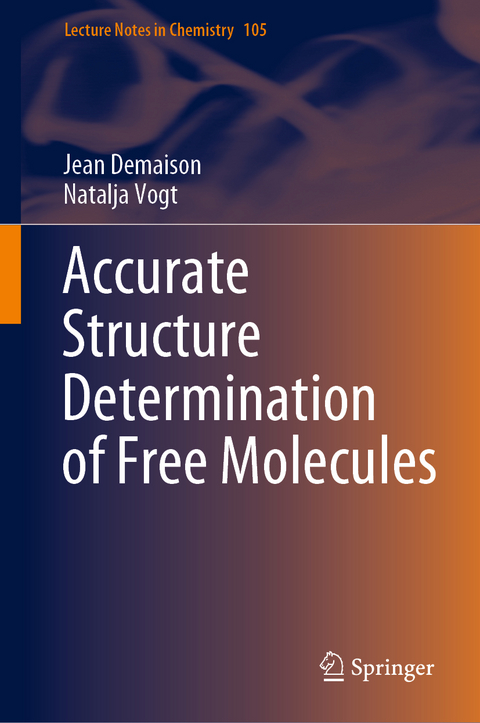
Accurate Structure Determination of Free Molecules
Springer International Publishing (Verlag)
978-3-030-60491-2 (ISBN)
This book presents a detailed look at experimental and computational techniques for accurate structure determination of free molecules. The most fundamental property of a molecule is its structure - it is a prerequisite for determining and understanding most other important properties of molecules. The determination of accurate structures is hampered by a myriad of factors, subjecting the collected data to non-negligible systematic errors. This book explains the origin of these errors and how to mitigate and even avoid them altogether. It features a detailed comparison of the different experimental and computation methods, explaining their interplay and the advantages of their combined use. Armed with this information, the reader will be able to choose the appropriate methods to determine - to a great degree of accuracy - the relevant molecular structure.
lt;p>Natalja Vogt received her Ph.D. in physical chemistry on the topic "Electron diffraction study of the first-row transition metal difluorides" from the Ivanovo University of Chemical Technology (now Russia) in 1986 in Prof. G. V. Girichev's group. In 1989, she received also her diploma in physics from Ivanovo State University, afterwards carrying out postdoctoral research at the Hungarian Academy of Sciences in Budapest in Prof. Istvan Hargittai's group from 1989 to 1990. As of 1991, she has been working in the Section of Chemical Information Systems (former Spectra and Structure Documentation) at the University of Ulm, Germany, and, since 2009, is employed there as a Senior Scientist. She is one of the establishers of the MOGADOC database for the structure of free molecules. In 2012, she prepared her habilitation thesis in physical chemistry at the Lomonosov Moscow State University on the topic "Determination of equilibrium structures of biomolecules". Since 2013, she is also Professor in the Chemistry Department at the Lomonosov Moscow State University. Between 1993 and 2014, she was a co-editor and/or co-author of the Landolt-Börnstein volumes "Structure Data of Free Polyatomic Molecules" (Group II: Molecules and Radicals; V.23, V.25(A-D), V.28(A-D), V.30(A, B)). Natalja Vogt has more than 120 peer-reviewed publications, including 16 books.
Jean Demaison studied chemical engineering at the École Nationale Supérieure des Industries Chimiques in Nancy, France, from 1964 to 1967. After being awarded his diploma in October of 1967, he obtained a position at the French Centre national de la recherche scientifique (CNRS) as a researcher in the theoretical chemistry laboratory at the University of Nancy. He received his Ph.D. in 1972, in this laboratory on the topic "Internal rotation of two top molecules in rotational spectroscopy" under the direction of Prof. Jean Barriol, in conjunction with research he carried out in Freiburg, Germany, under the direction of Prof. Heinz Dieter Rudolph.
After his military service from February 1974 to June 1975, he was Gastdozent at the Laboratory of Physical Chemistry at the University of Ulm. After that he re-joined CNRS at the laboratory of Spectroscopie Hertzienne of Lille University. After working on molecular beam spectroscopy, he moved to the study of molecules of astrophysical interest. More recently, he switched to the utilization of quantum chemistry with emphasis on determining the molecular properties of molecules.
He was promoted Research Director at CNRS in 1985. From 2001 to 2004, he was a Guest Professor at the University of Louvain-La-Neuve, and from 2006 to 2008, at the Free University of Brussels. He was also a Visiting Scientist in several laboratories (Austin, Kiel, Mühlheim, Valladolid). Jean Demaison published more than 370 papers and 22 books.
Introduction.- Computational methods.- Diatomic molecules.- Rotation of the polyatomic molecule.- The vibrations of polyatomic molecule.- Equilibrium structures from spectroscopy.- Molecular structures from gas-phase electron diffraction.- Models of chemical bonding and "empirical" methods.- Least-squares method.- Databases with information on molecular structure.
| Erscheinungsdatum | 07.01.2021 |
|---|---|
| Reihe/Serie | Lecture Notes in Chemistry |
| Zusatzinfo | XVIII, 277 p. 42 illus., 24 illus. in color. |
| Verlagsort | Cham |
| Sprache | englisch |
| Maße | 155 x 235 mm |
| Gewicht | 612 g |
| Themenwelt | Naturwissenschaften ► Chemie ► Analytische Chemie |
| Naturwissenschaften ► Chemie ► Physikalische Chemie | |
| Naturwissenschaften ► Physik / Astronomie ► Atom- / Kern- / Molekularphysik | |
| Technik ► Maschinenbau | |
| Schlagworte | Determination of molecular structure • electron diffraction • Equilibrium Structure • Molecular Modelling • molecular structure • rotational spectroscopy • Structure of free molecules • X-ray structure |
| ISBN-10 | 3-030-60491-8 / 3030604918 |
| ISBN-13 | 978-3-030-60491-2 / 9783030604912 |
| Zustand | Neuware |
| Haben Sie eine Frage zum Produkt? |
aus dem Bereich


